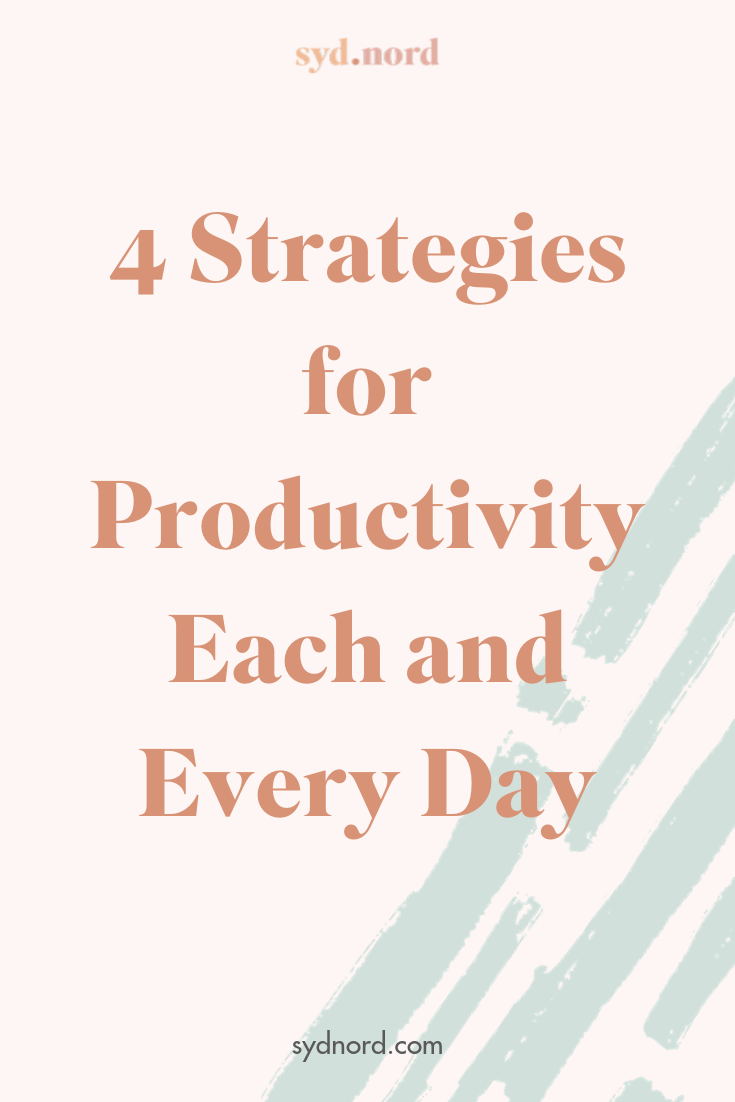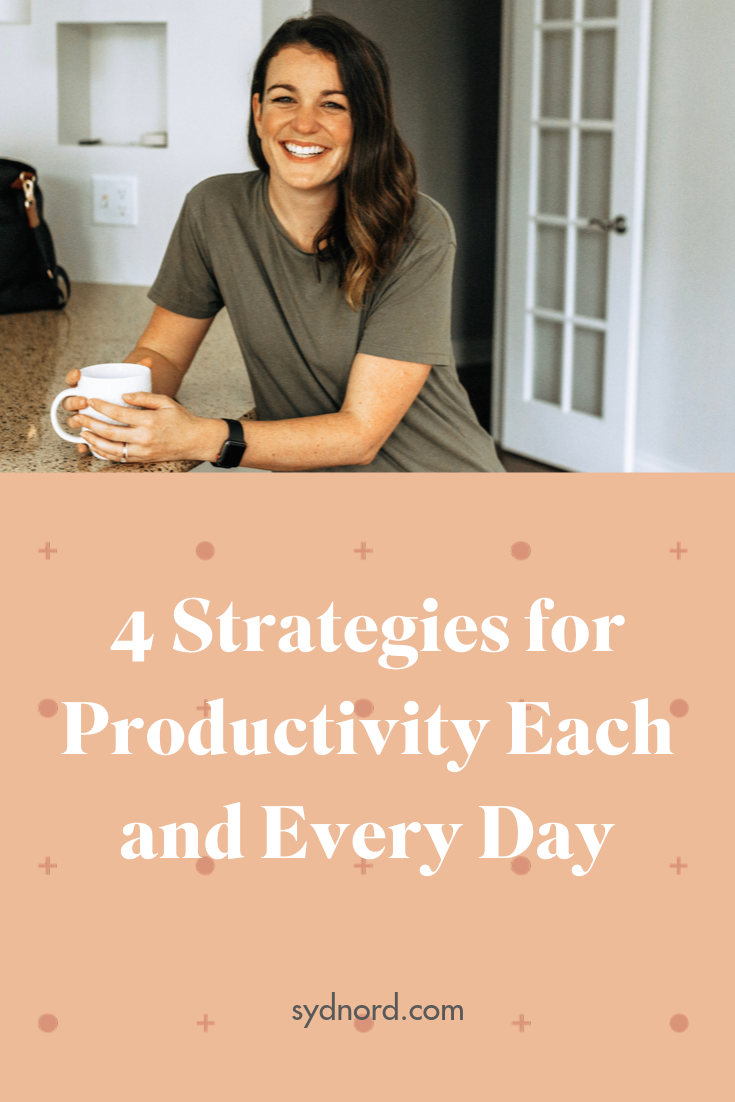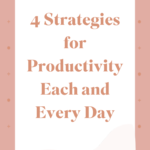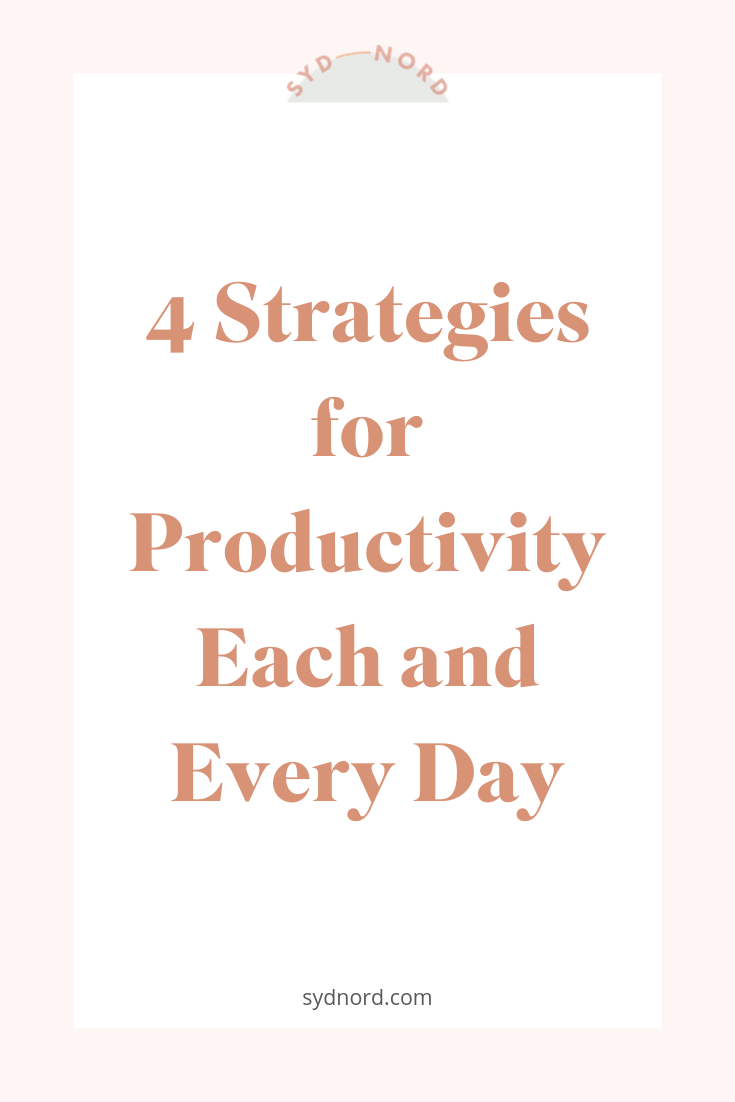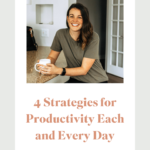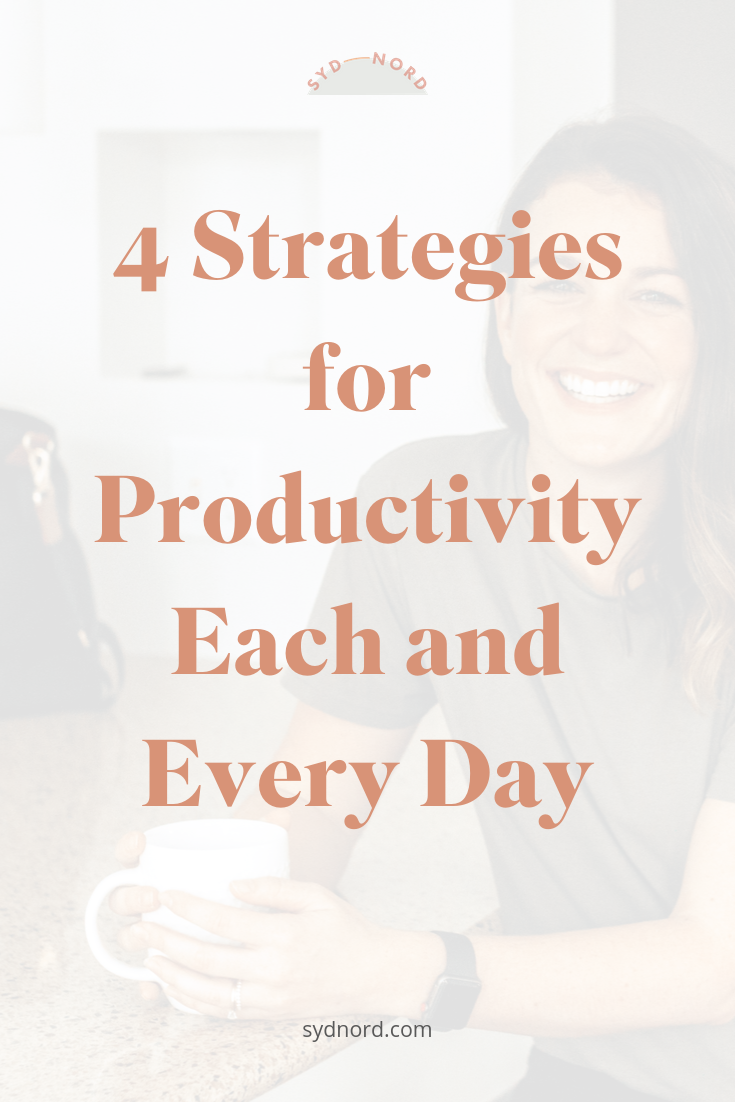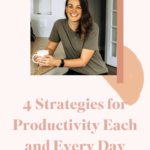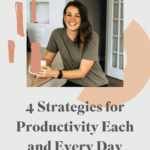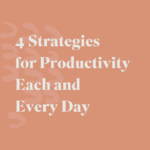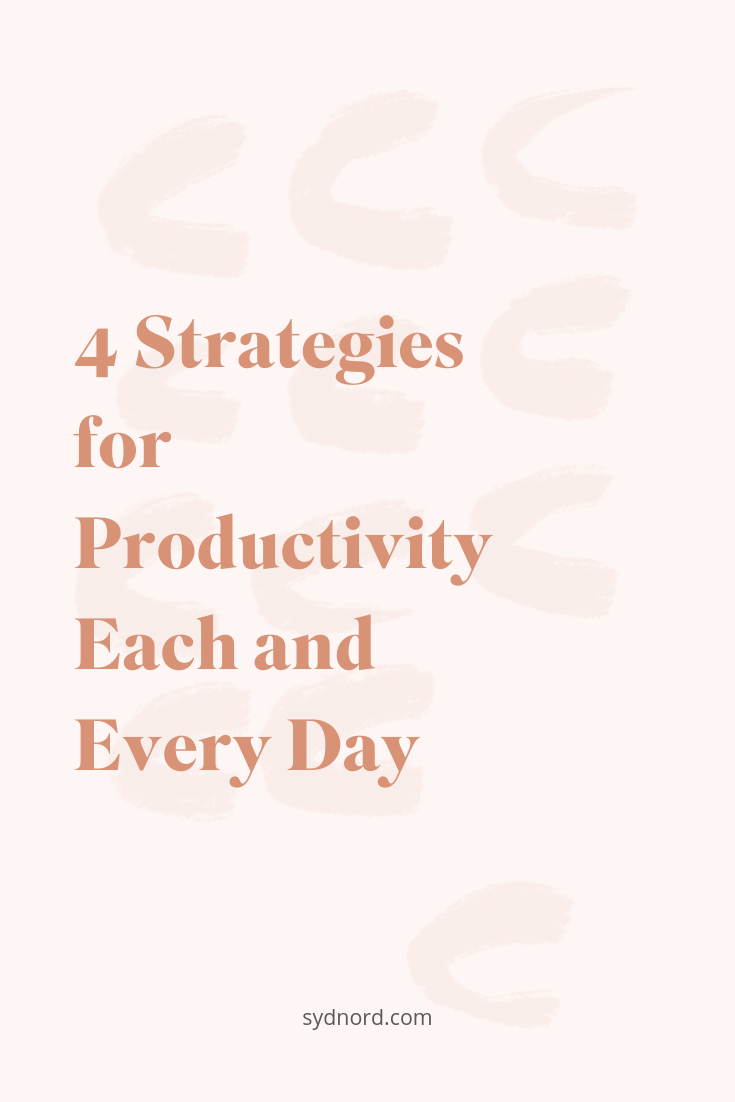I recently saw the coziest, most delicious fall sweater while scrolling on Pinterest. This was one of those sweaters that you could wear anywhere and feel like a snuggly million bucks. So I clicked on the pin. And nothing. Nothing! The link lead to a scary website with aggressive highlighter colors flashing in my face and no cozy sweater in sight.
I tried Googling it. But apparently cozy delicious fall sweater isn’t descriptive enough (lol).
Knowing what I wanted was helpful. Not understanding how to get there was super frustrating.
If you like the idea of productivity — doing your list of important things in less time — but you’re not sure how to make it happen, let’s fix that! Here are four strategies for productivity I use to work productivity into my day and my week.
1. Prioritize (and eliminate) so the most important things get done
“What is important is seldom urgent and what is urgent is seldom important.”
Dwight D. Eisenhower
Ready for a little history? I was first introduced to the Eisenhower Decision Matrix by a friend at work. It was created by Dwight D. Eisenhower (yes, the President) and became super popular after gracing the pages of Stephen Covey’s book The 7 Habits of Highly Effective People.
This matrix is all about labeling your tasks as some combination of urgent and important to determine it’s place among your priorities. It’s a strategies-for-productivity superstar that will help you prioritize (and maybe even eliminate some of) your tasks.
Urgent
If something is urgent it needs immediate action. These are the to-dos on your list that feel like they are literally screaming at you, so loudly that you feel compelled to complete them asap. Oftentimes, it’s reactive.
When I was cooking dinner the other day I heard a strange sound and found Hayes playing in the water from our dog’s bowl. She dumped the whole thing out onto the ground and was soaking wet from splashing around in it. After letting her enjoy that for a second — live a little, right? — I scooped her up, got her changed, mopped up the water, and found a new home for the water bowl.
That was urgent to me, because it was a mess and was only going to get messier, but was it important?
Important
If something actually moves the needle and contributes to goals for you, your family, your work, etc. then it’s important. These tasks are typically not urgent and are handled with calm and intentionality.
Jeff and I are big on budgeting. So every Sunday night after we go over our calendars for the week, we talk through what we spent the previous week, and look at our numbers for the month. Our budget meeting is something that we intentionally and proactively work into our week. It’s important to our financial stability as a family and the goals we have for our future plans (kids, education, travel, retirement, etc.).
The Eisenhower Decision Matrix
It might seem easy to prioritize in the moment, but distinguishing whether whether something is urgent and important can be hard. Especially when that urgent thing is screaming at you and you suddenly forget about that important thing.
But here’s a handy tool to help you with determining what needs to get done (the priorities) and what can wait (bottom of the list or off the list). Take a look at this matrix and think about what falls into your important and not important quadrants.

Are there things you are spending time on that won’t lead you to your goals? Are there things you need to stop all together?
Prioritizing (perhaps with the help of this matrix) helps you identify the important things and put them first in your life.
Recently, Jeff and I just realized we were spending more time than we wanted to in the lower right quadrant (not urgent, not important). We were watching a lot of tv toward the end of summer and spending less present time with one another after Hayes was in bed. So we decided to stop watching tv for the month of October. Now that we have eliminated a time waster for the month, we are seeing other things on our list of prioritize take off.
When I see the success of prioritizing it’s even easier for me to be more aware of whether a task is urgent vs. important and prioritize on the fly. It feels so good to get the important things taken care of.
2. Batch for better efficiency
If you aren’t doing this yet, it’s a super easy thing to add to your strategies for productivity and totally worth it.
Batching is “arranging (things) into sets or groups” — essentially, finding like-tasks that easy go together and knocking them off of your list at once instead of one-by-one to save time.
There are some forms of batching that you might already do without realizing it. Maybe you have a dedicated day for meal prep when you cut up all of the veggies + meat that you will be using throughout the week in one sitting instead of each day. Or maybe you clean all of the bathrooms in your house at once instead of one at a time.
Why I love batching for productivity
Batching cuts down on the number of tasks on your list
Instead of Monday meal prep, Tuesday meal prep, Wednesday meal prep, etc., it’s just Sunday meal prep for the week.
Batching eliminates duplicate ramp up and ramp down tasks
Instead of taking out the cutting board, using it, washing it, and putting it away x7, it’s just once!
Batching creates efficiency
Have you ever felt like you were “in the zone” with a task? Batching takes advantage of your “in the zone” time and makes the whole thing go faster.
Batching is something I started to use at work and found huge success. One of my tasks is to review content and provide feedback to our copywriters. I use to review them throughout the day whenever they came up or whenever I had a free moment, which was not productive or my best work. Now I batch review all content at once between 7:30am – 8:30am daily. I don’t think I will never go back because it’s an incredibly productive shift in my workflow.
3. Time-box to create ultimate focus
Have you ever heard of Parkinson’s Law? When it comes to strategies for productivity, this can’t be missed. Parkinson’s Law states that “work expands so as to fill the time available for its completion”.
Basically if I tell myself I have an hour to clean up my kitchen, it will take me an hour to clean up my kitchen. And if I tell myself I have 10 minutes to clean up my kitchen, it will take me 10 minutes to clean up my kitchen.
Think about the last time you packed for a weekend trip. As I write this, I am just days away from packing up for a girl’s trip. If I give myself Thursday night to pack, I’ll likely spend an hour packing that night. But if I wait until 30 minutes before everyone arrives at my house to go, I’ll do that same packing in half the time without even thinking about it.
(Yes, I do see you nodding your head.)
The best way to take advantage of Parkinson’s Law to assist your productivity is to time-box your tasks. You can do this on the fly — “I’m going to spend the next 10 minutes cleaning the kitchen” — or planned out and deliberate — “let’s block off an hour on our calendar Saturday afternoon to clean out the garage”.
Unfortunately, Parkinson’s Law doesn’t mean that you can clean your bathroom in 30 seconds. That would be cool. The key is to give yourself an achievable amount of time to complete it, but eliminate the extra time that is usually spend overthinking or unfocused. I am constantly experimenting to figure out how much time I really need to complete a task. I can vacuum our entire house in about 11 minutes from the time I get the vacuum out of the closet to the time I put it back in, but the first time I time-boxed that, I guessed 20 minutes.
Try time-boxing some activities this week and see how much more productive your tasks become!
4. Make a plan of attack
Have you ever looked at your list of tasks and been so overwhelmed by what you need to do and where to start that you do nothing at all?
I have definitely been there. Instead of actually doing something I take 20 minutes turning in circles trying to figure out what I’m suppose to do to make the best use of my time. How incredibly ironic.
Plan-less is not productive.
It’s time to plan out when you’re going to complete the things on your list. I’ve found that making my plan of attack works really well if I have used the previous strategies — prioritize, batch, time-box — because then I’m just finding the appropriate spot for each task during my day or my week.
All strategies for productivity need a tool of choice and I have three when making my plan of attack — a notepad, pen, and Google Calendar. You probably already have a hunch as to what works for you and those three tools might not be it, but I’m a huge fan of the technology + analog combination.
I use Google Calendar for my weekly view
My Google Calendar is the hub of everything that I have going on — it’s the big picture look at my to-dos that’s shared with Jeff so we both know what our family has going on. We meet to add all of our tasks to the Google Calendar every Sunday night — I have a post coming up that outlines this entire process that I’m very excited to share because it’s been the catalyst to eliminating chaos in our house.
I use a pen + paper for my daily view
I use a notepad + pen to tackle my nitty gritty daily tasks. I have a notepad at my desk at work to write out my work tasks and a personal notepad to outline my personal tasks.
I don’t write as detailed as, “take out the trash – 6:10am” because that’s not realistic for me, but I do list a few things that I want to complete in the morning from the time I wake up (4:50am to the time I leave for work 7:15am). I might write “take out trash, listen to Audible for 30 minutes, meditate, 15 minute Tabata workout”.
Bonus: I just started to share my personal tasks on my Instagram Stories so you can see exactly how I plan to tackle my tasks for the day. Take a look at let me know if it’s helpful!
Remember to be realistic with your list
I have found a ton of success from consistently using these four strategies for productivity. But there is one thing that can really throw my productivity for a loop and it’s something that I have to constantly remind myself about.
The number of tasks on my to-do list matters.
When I prioritize, batch, time-box, and plan I often feel like I can load up the tasks and keep adding more and more. But a list of to-dos that never gets completed is painful, demotivating, and ruins that hard work your strategies for productivity put in. And let’s not forget the point of being productive is not to do more, it’s to do the things on your list faster so you can have more time for the good life.
One of the keys to success is to put an achievable amount of tasks on your to-do list. That way when you’re productive you get rewarded with the space you created to spend time with family, to soak up laughter and fresh air, to do whatever will light your heart on fire.
I hope these strategies for productivity return some time to your day and your week. I can’t wait to hear about it.
